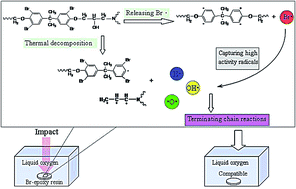Liquid oxygen compatible epoxy resin: modification and characterization
Abstract
The bisphenol A epoxy resin was modified by the polycondensation between tetrabromobisphenol A and bisphenol A epoxy resin. After curing using 4,4′-diaminodiphenyl methane (DDM) and 4,4′-diaminodiphenyl sulfone (DDS), the liquid oxygen compatibility of bisphenol A epoxy resin and modified bisphenol A epoxy resin was measured by the mechanical impact test (ASTM D2512-95). The results suggested that the modified bisphenol A epoxy resin curing using 4,4′-diamino diphenylmethane (DDM) was compatible with liquid oxygen. The thermogravimetric analysis (TGA) revealed that the modified bisphenol A epoxy resin has lower temperatures of the initial degradation and the maximum mass loss rate compared with unmodified. The X-ray photoelectron spectroscopy (XPS) measurement results indicated that the C–C/H groups were oxidized to C–O–C/H and/or C![[double bond, length as m-dash]](https://www.rsc.org/images/entities/char_e001.gif) O groups during the impact process. The mechanical properties of all samples were measured at room temperature (RT) and nitrogen temperature (77 K). The flame-retardant modification of epoxy resin may be an effective way to obtain the compatible epoxy resin material with liquid oxygen.
O groups during the impact process. The mechanical properties of all samples were measured at room temperature (RT) and nitrogen temperature (77 K). The flame-retardant modification of epoxy resin may be an effective way to obtain the compatible epoxy resin material with liquid oxygen.


 Please wait while we load your content...
Please wait while we load your content...